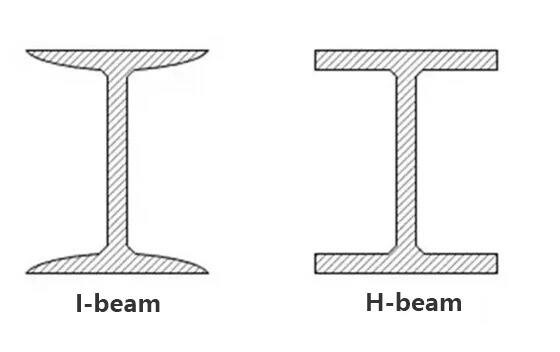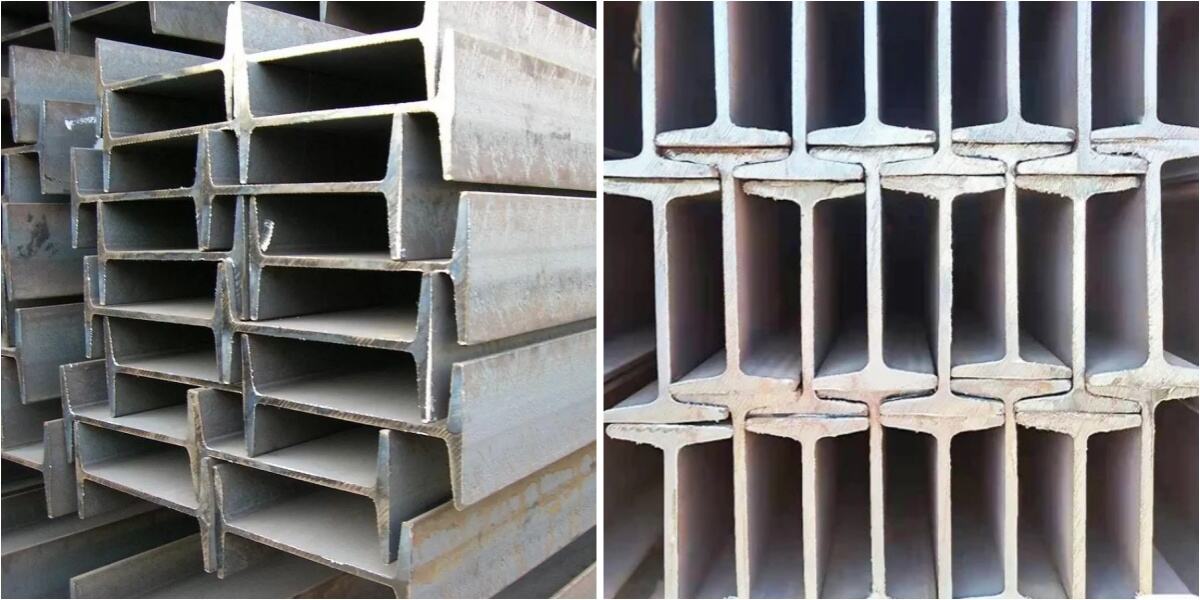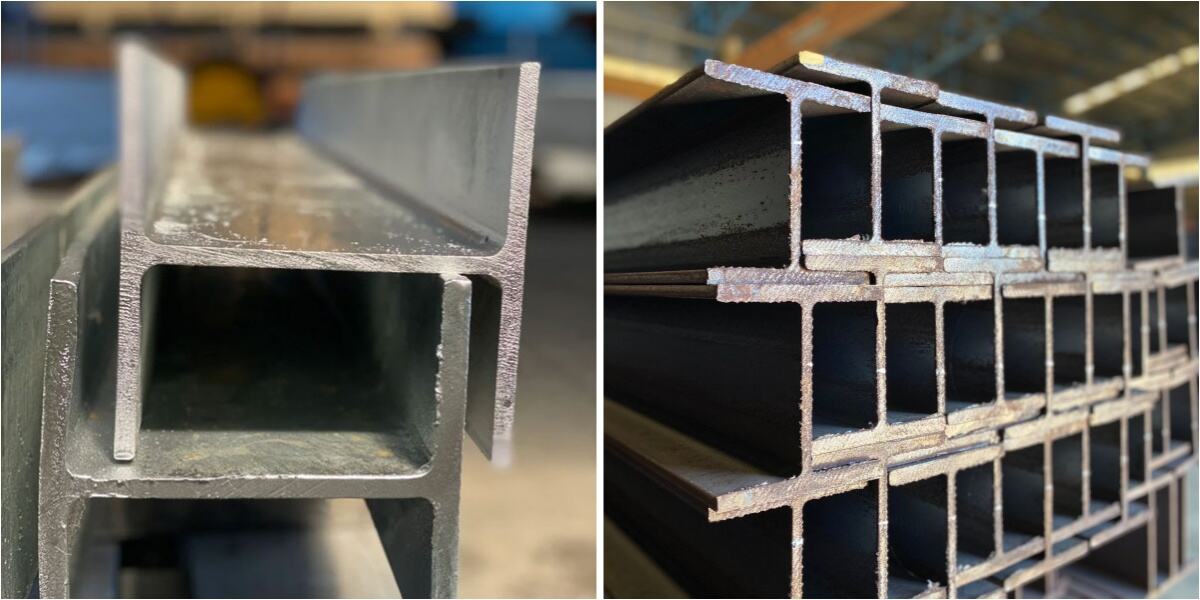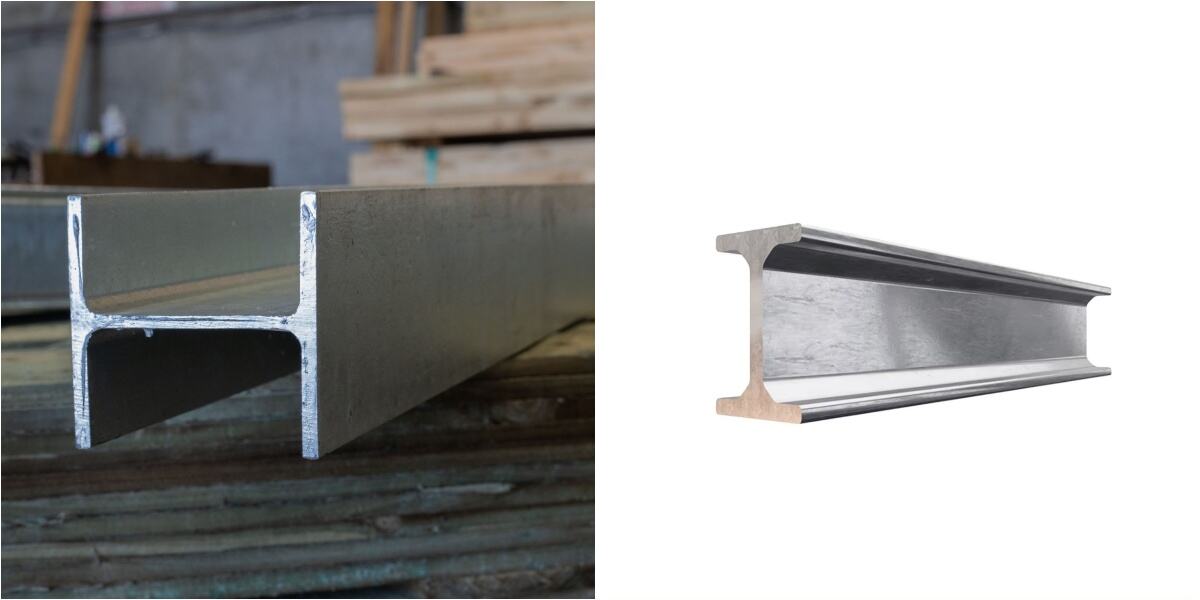ผู้คนมักถามว่าจะเลือกอย่างไรระหว่างคานรูปตัว I และ H-beam ซึ่งมีลักษณะคล้ายคลึงกัน?
หลายคนคิดว่าคานรูปตัว I เป็นชื่อในจีนและคานรูปตัว H เป็นชื่อต่างประเทศ แต่ความจริงแล้วความเข้าใจนี้ผิด คานรูปตัว H และคานรูปตัว I มีความแตกต่างกันในด้านรูปร่าง ดังที่แสดงในภาพด้านล่าง:

คานรูปตัว I คืออะไร?
วงศ์ I เรียกอีกอย่างว่าคานเหล็ก และรูปร่างหน้าตัดของมันเป็นรูปตัวอักษร "I" ส่วนขอบของคานรูปตัว I เหมือนกับคานรูปตัว H แต่ส่วนกลางของคานรูปตัว I มักบางกว่าคานรูปตัว H และขอบค่อนข้างแคบ
คานรูปตัวไอถูกแบ่งออกเป็นหลักๆ สามประเภท ได้แก่ คานรูปตัวไอทั่วไป คานรูปตัวไอเบา และคานรูปตัวไอขอบกว้าง โดยพิจารณาจากอัตราส่วนของขอบกับความสูงของแผ่นกลาง จะแบ่งออกเป็นคานรูปตัวไอขอบกว้างแบบกว้าง กลาง และแคบ สเปคของสองประเภทแรกคือ 10-60 ซึ่งหมายถึงความสูงที่สอดคล้องกันคือ 10-60 เซนติเมตร
ในความสูงเดียวกัน คานรูปตัวไอเบามีขอบแคบ แผ่นกลางบางและน้ำหนักเบา คานรูปตัวไอขอบกว้างยังเรียกว่าคานรูปตัวเอช ลักษณะตามแนวตัดขวางของมันคือขาทั้งสองขนานกันและไม่มีการเอนเข้าด้านในของขา เป็นเหล็กกล้าที่มีหน้าตัดประหยัด และถูกผลิตบนเครื่องอัดรีดแบบสี่ลูกกลิ้งแบบทั่วไป ดังนั้นจึงเรียกอีกอย่างว่า "คานรูปตัวไอทั่วไป" คานรูปตัวไอทั่วไปและคานรูปตัวไอเบามีมาตรฐานแห่งชาติแล้ว
ตามชื่อที่แนะนำ คานรูปตัว I เป็นเหล็กที่มีหน้า截面รูปตัว "I" พื้นผิวด้านในของแผ่นปีกบนและล่างมีความเอียงโดยทั่วไปอยู่ที่ 1:6 ซึ่งทำให้แผ่นปีกบางด้านนอกและหนาด้านใน ผลลัพธ์คือ คุณสมบัติทางหน้า截面ของคานรูปตัว I ในสองระนาบหลักนั้นแตกต่างกันมาก และยากที่จะแสดงคุณสมบัติความแข็งแรงของเหล็กเมื่อนำไปใช้งาน แม้ว่าจะมีคานรูปตัว I ที่หนาขึ้นปรากฏในตลาดคานรูปตัว I แล้ว แต่โครงสร้างของคานรูปตัว I ได้กำหนดข้อบกพร่องในการทนแรงบิดไว้แล้ว

อะไรคือคานรูปตัว H?
คานรูปตัว H เป็นเหล็กที่มีหน้า截 section รูปตัว "H" โดยประกอบด้วยแผ่นปีกสองด้านที่ขนานกันและเว็บที่ตั้งฉาก
เหล็กทรงตัว H เป็นโปรไฟล์ที่ประหยัดและมีประสิทธิภาพด้วยการกระจายพื้นที่ส่วนตัดที่ได้รับการปรับแต่งให้ดียิ่งขึ้น และมีอัตราส่วนความแข็งแรงต่อน้ำหนักที่เหมาะสมกว่า มันถูกเรียกว่า "H" เพราะส่วนตัดของมันเหมือนกับตัวอักษรภาษาอังกฤษ "H" เนื่องจากทุกส่วนของเหล็กทรงตัว H จัดเรียงอยู่ในมุมฉาก ทำให้เหล็กทรงตัว H มีคุณสมบัติในการต้านทานการงอที่แข็งแกร่ง การก่อสร้างที่ง่าย ประหยัดต้นทุน และโครงสร้างที่เบาในทุกทิศทาง และได้รับการใช้งานอย่างแพร่หลาย
เหล็กทรงตัว H เป็นโปรไฟล์ที่ใช้งานกันอย่างแพร่หลายในอาคารโครงสร้างเหล็กยุคปัจจุบัน มันมีความแตกต่างมากมายเมื่อเปรียบเทียบกับเหล็กทรงตัว I ก่อนอื่นคือแผ่น冀 (flange) และประการที่สองคือผิวด้านในของแผ่น冀ไม่มีความเอียง และพื้นผิวด้านบนและล่างขนานกัน คุณลักษณะของส่วนตัดของเหล็กทรงตัว H มีความโดดเด่นมากกว่าเหล็กทรงตัว I แบบดั้งเดิม เหล็กช่อง และเหล็กมุม
ด้านในของขอบนอกสองด้านของเหล็กทรงตัว H ไม่มีความเอียงและเป็นเส้นตรง ซึ่งทำให้การเชื่อมและการต่อเหล็กทรงตัว H ง่ายกว่าเหล็กทรงตัว I และคุณสมบัติทางกลต่อหน่วยน้ำหนักดีกว่า สามารถประหยัดวัสดุและเวลาในการก่อสร้างได้มาก ส่วนโครงสร้างตัว I มีประสิทธิภาพดีในการรับแรงกดและแรงดึง แต่ขนาดของส่วนตัดไม่สามารถต้านแรงบิดได้เพราะแผ่นปีกแคบเกินไป เหล็กทรงตัว H เป็นข้อตรงกันข้าม และทั้งสองประเภทก็มีข้อดีข้อเสียของตัวเอง

วิธีแยกแยะคานตัว I และคานตัว H จากลักษณะภายนอก?
คานตัว I (I-beams) และคานตัว H มีความแตกต่างกันอย่างชัดเจนในลักษณะภายนอก โดยเฉพาะในรูปร่างของส่วนตัด นี่คือความแตกต่างหลักในลักษณะระหว่างสองชนิดของเหล็ก:
- คานรูปตัว I (เหล็กทรงตัว I): หน้า截面ของคานรูปตัว I มีลักษณะเป็นตัวอักษร "I" โดยเฉพาะอย่างยิ่ง หน้า截section ของคานรูปตัว I จะประกอบด้วยส่วนเว็บ (ส่วนกลาง) และแผ่นขอบ (ส่วนบนและล่าง) แผ่นขอบมักจะแคบและเว็บบาง ทำให้รูปร่างหน้า截sectionโดยรวมดูเหมือนตัว "I" ที่เรียบง่าย
-
คานรูปตัว H: หน้า截section ของคานรูปตัว H มีลักษณะเป็นตัวอักษร "H" และประกอบด้วยเว็บและแผ่นขอบเช่นกัน แต่แตกต่างจากคานรูปตัว I แผ่นขอบของคานรูปตัว H จะกว้างและหนากว่าของคานรูปตัว I และเว็บจะบางกว่าเมื่อเทียบกัน

คานรูปตัว H กับคานรูปตัว I
อะไรคือ ความแตกต่างระหว่างคานรูปตัว H และคานรูปตัว I ?
ไม่ว่าจะเป็น I-beam แบบทั่วไปหรือแบบเบา มีขนาดตัดขวางที่ค่อนข้างสูงและแคบ ส่งผลให้โมเมนต์เฉื่อยของแกนหลักสองแกนของหน้าตัดแตกต่างกันมาก ดังนั้นโดยทั่วไปสามารถใช้งานได้เพียงสำหรับโครงสร้างที่ถูกงอในระนาบของแผ่นเว็บ หรือใช้ประกอบเป็นโครงสร้างรูปตาข่ายเท่านั้น ไม่เหมาะสำหรับใช้ในโครงสร้างที่ถูกบีบอัดตามแกน หรือโครงสร้างที่ถูกงอในทิศทางตั้งฉากกับแผ่นเว็บ ซึ่งจำกัดขอบเขตการใช้งานอย่างมาก
2. คานรูปตัวเอชเป็นโปรไฟล์หน้า截ที่มีประสิทธิภาพสูงและประหยัด (อื่นๆ เช่น เหล็กแผ่นบางที่งอเย็น แผ่นเหล็กเกลียว เป็นต้น) เนื่องจากมีรูปร่างหน้า截ที่เหมาะสม จึงสามารถทำให้เหล็กทำงานได้อย่างมีประสิทธิภาพมากขึ้นและเพิ่มความสามารถในการต้านแรงเฉือน เมื่อเทียบกับคานรูปตัวไอทั่วไป ปีกของคานรูปตัวเอชจะกว้างขึ้น และพื้นผิวด้านในและด้านนอกมักจะขนานกัน ซึ่งทำให้เชื่อมต่อกับชิ้นส่วนอื่นด้วยน็อตความแข็งแรงสูงได้ง่าย นอกจากนี้ขนาดของมันยังสร้างเป็นชุดที่เหมาะสม มีรุ่นที่ครบถ้วน สะดวกต่อการออกแบบและการเลือกใช้ (ยกเว้นคานรูปตัวไอสำหรับคานเครน)
3.แผ่นกันของเหล็กทรงตัว H มีความหนาเท่ากัน ประกอบด้วยส่วนที่ขึ้นรูปด้วยการกลิ้งและส่วนที่ประกอบจากแผ่นสามแผ่นที่เชื่อมเข้าด้วยกัน เหล็กทรงตัว I เป็นส่วนที่ขึ้นรูปด้วยการกลิ้ง เนื่องจากเทคโนโลยีการผลิตที่ไม่ดีพอ ขอบในของแผ่นกันจึงมีความชัน 1:10 การกลิ้งของเหล็กทรงตัว H แตกต่างจากการกลิ้งของเหล็กทรงตัว I ทั่วไปซึ่งใช้เพียงชุดลูกกลิ้งแนวนอนชุดเดียว เนื่องจากแผ่นกันกว้างและไม่มีความชัน (หรือความชันเล็กมาก) จึงจำเป็นต้องเพิ่มชุดลูกกลิ้งแนวตั้งสำหรับการกลิ้งพร้อมกัน ดังนั้นกระบวนการและการใช้อุปกรณ์ในการกลิ้งจึงซับซ้อนกว่าโรงงานกลิ้งทั่วไป ส่วนสูงสูงสุดของเหล็กทรงตัว H ที่สามารถผลิตได้ในประเทศจีนคือ 800 มม. หากเกินขนาดนี้ จะต้องเป็นส่วนที่เชื่อมรวมกัน
4.ความยาวด้านของเหล็กทรงตัว I มีขนาดเล็กและสูงมาก ดังนั้นสามารถทนแรงได้เพียงทิศทางเดียว
5.ร่องของเหล็กทรงตัว H มีความลึกและความหนามาก สามารถทนแรงได้สองทิศทาง
6.ด้วยการพัฒนาของอาคารโครงสร้างเหล็ก การใช้เพียงเหล็กทรง I อาจไม่เพียงพอ เนื่องจากเหล็กทรง I ที่หนากว่ามีแนวโน้มที่จะไม่มั่นคงเมื่อถูกนำมาใช้เป็นเสาชูน้ำหนัก
7.เหล็กทรง I สามารถใช้สำหรับคานได้เท่านั้น ในขณะที่เหล็กทรง H สามารถใช้สำหรับเสาชูน้ำหนักของโครงสร้างได้
8.เหล็กทรง H เป็นเหล็กที่มีส่วนตัดขวางทางเศรษฐกิจดีกว่า โดยมีคุณสมบัติกลของส่วนตัดขวางที่ดีกว่าเหล็กทรง I มันถูกเรียกว่า H เพราะรูปร่างส่วนตัดขวางเหมือนตัวอักษรภาษาอังกฤษ "H" แผ่นระนาบที่อยู่ในเหล็กทรง H จากกระบวนการหล่อร้อนกว้างกว่าแผ่นระนาบของเหล็กทรง I และมีความแข็งแรงตามแนวนอนมากกว่าและมีความสามารถในการต้านทานแรงงอที่ดีกว่า ในกรณีที่มีขนาดเท่ากัน เหล็กทรง H จะมีน้ำหนักเบากว่าเหล็กทรง I
9.แผ่นระนาบของเหล็กทรง I เป็นส่วนที่มีความหนาไม่เท่ากัน โดยหนาขึ้นใกล้กับแกนกลางและบางลงด้านนอก ในขณะที่แผ่นระนาบของเหล็กทรง H เป็นส่วนที่มีความหนาเท่ากัน
10.HW, HM และ HN เป็นชื่อทั่วไปสำหรับเหล็กทรง H เหล็กทรง H ถูกเชื่อม ส่วน HW, HM และ HN ถูกหล่อร้อน
11.HW เป็นคานรูปตัวเอชซึ่งมีความสูงและความกว้างของแผ่นกันน้ำพื้นฐานเท่ากัน โดยทั่วไปแล้วจะใช้สำหรับเสาแกนเหล็กในโครงสร้างคอนกรีตเสริมแรง นอกจากนี้ยังเรียกว่าเสาเหล็กแข็ง และใช้เป็นหลักสำหรับเสาในโครงสร้างเหล็ก
12.HM เป็นอัตราส่วนของความสูงของคานรูปตัวเอชต่อความกว้างของแผ่นกันน้ำประมาณ 1.33~1.75 โดยทั่วไปแล้วจะใช้ในโครงสร้างเหล็ก: ใช้เป็นเสาเฟรมเหล็ก และใช้เป็นคานเฟรมในโครงสร้างเฟรมที่รองรับโหลดพลศาสตร์ เช่น: แพลตฟอร์มอุปกรณ์
13.HN เป็นอัตราส่วนของความสูงของคานรูปตัวเอชต่อความกว้างของแผ่นกันน้ำมากกว่าหรือเท่ากับ 2 โดยทั่วไปแล้วจะใช้สำหรับคาน การใช้งานของคานไอเทียบเท่ากับคาน HN
เราเป็นผู้ผลิตเหล็กมืออาชีพ หากคุณมีความต้องการใด ๆ คุณสามารถติดต่อเราได้ตลอดเวลา!
 +86 17611015797 (WhatsApp )
+86 17611015797 (WhatsApp )  info@steelgroups.com
info@steelgroups.com
